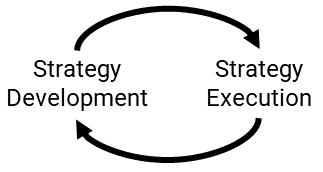Introduction
The world around us is always changing and evolving. To remain successful (or to become even more successful), organisations must change and evolve with it.
A well-crafted strategy is a blueprint describing exactly how an organisation intends to do that.
In this article, we
- look at the core of business strategy development and execution and
- present 6 summary business strategy examples to demystify the art of crafting an effective one.
What is Business Strategy Development and Execution?
Business strategy development and execution is the process of:
- conceiving and executing a new strategy
or - adapting an existing one to meet an organisation's evolving objectives.
The strategy itself is a game plan designed to steer the company toward its desired destination.
It acts as the compass, setting the direction for key decisions and actions, like
- expanding into new markets
- developing new products, services or capabilities.
It provides a framework within which all other decisions should be made.
 Some people still look at development and execution as two separate processes, one preceding the other. However, the truth is that they co-exist simultaneously in time.
Some people still look at development and execution as two separate processes, one preceding the other. However, the truth is that they co-exist simultaneously in time.
As an organisation executes its existing strategy, the world continues to change. So the organisation must continually review and adjust its strategy. (See diagram to the right.)
Strategy is often perceived to be long-term in nature. This is because:
- significant changes take time to execute and
- because it takes time to earn back on significant investments made.
However, strategy is as much about the decisions needed today as it is about the long term.
Strategy must balance the short term, medium term and long term. (See the Three Horizons model.)
Why is Business Strategy Development and Execution Essential?
A well-crafted business strategy is pivotal role in a company's journey towards success. It is indispensable because:
- Clear Direction: A specific strategy offers employees a distinct purpose. This ensures their decisions align with the company's objectives. It enables greater collaboration and faster decision making.
- Resource Allocation: It assists in deciding how to allocate resources among various projects and ventures to maximise efficiency and results. This involves selection, prioritisation and sequencing of efforts.
Factors to Consider When Developing a Business Strategy
Developing a business strategy requires careful consideration of several factors. A successful strategy:
- Is clear and concise. It should describe what should not be done as much as what should be done.
- Is supported by measurable and specific targets. This will instil belief in its achievability.
- Is viable given the prevailing competitive and market dynamics. Remember that whatever strategies you plan, your competitors may be planning their own strategies to neutralise and/or defeat them.
- Exploits untapped or underserved opportunities. And it assesses how these opportunities might evolve over time.
- Addresses the challenges an organisation faces. These can be just as important as the opportunities.
- Considers time to market. When developing new products or services, time-to-market is paramount to prevent irrelevance due to changing consumer preferences.
- Considers stakeholder Impact: A strategy affects all stakeholders - management, employees, partners, and shareholders. Evaluating its impact on each stakeholder is vital. New strategies create winners and losers - in relative if not absolute terms.
- Creates value. No business and no business strategy succeeds unless it creates value for its customers, its owners/shareholders, its employees, and its other stakeholders. Value is created when the (perceived) value delivered to customers (or other stakeholders) is greater than the price they must pay for it.
- Considers risk: Business and strategy are inherently risky. There are no guarantees. A good strategy will take those risks into account and take steps to mitigate and detect problems early.
- Is regularly reviewed and updated: Regular reviews and updates keep the strategy in sync with market developments and the company's evolving goals and objectives.
How to Develop and Execute a Business Strategy
To create a business strategy that aligns with your company's vision, follow these steps:
- Develop an objective analysis: Before trying to decide on a strategy, it is important to develop a shared and objective understanding of the challenges and opportunities an organisation faces.
- Set a strategic direction: Start by defining the company's long-term goal(s). Consider financial and operational capabilities, as well as market conditions. These include changing customer needs and expectations, and competitors and other market participants. Be realistic and focus on achievable goals. These can be summarised in a mission statement, and/or a vision statement. They should also be broken down into nearer-term (and SMART) objectives with key performance indicators (KPIs) and targets.
- Create a plan: Develop a comprehensive plan that outlines who will do what and by when to achieve the goal(s). Include cost and benefit assumptions. This plan establishes roles, responsibilities and expectations, and guides employees' decision-making.
- Track progress and update: As you execute the strategy, monitor progress and share this with stakeholders. If circumstances change, or the strategy does not perform as expected, adjust and update the strategy.
6 Business Strategy Examples
There is an infinite variety of business strategies, and people are coming up with new ones all the time. Therefore, despite several attempts to develop one, there is no definitive list of business strategies. Each business should develop strategies which are unique to its particular circumstances and goals.
The following list, therefore, should be treated as illustrative examples only:
- Growing Market Share in a New Market: Expanding market presence by opening new stores/channels or investing in advertising in new markets.
- Product Differentiation: Distinguishing products from competitors to build customer loyalty and gain market share.
- Developing Innovative Products: Developing innovative products to meet consumer needs and increase market dominance.
- Improving Customer Acquisition and Retention: Acquiring new customers by incentivising and retaining them with excellent customer service and loyalty programmes.
- Attaining a Technological Advantage: Investing in research and development to gain a technological edge, leading to cost efficiencies and profitability.
- Mergers, acquisitions, disposals and carveouts: Growing, shrinking or changing shape and capabilities by buying other organisations or selling part of themselves.
A single organisation can pursue a number of strategies at the same time, where these are mutually reinforcing. However, organisations should resist the temptation to pursue too many strategies at the same time, as this leads to a loss of focus.
Levels of business strategies
More complex businesses may set strategy at numerous levels. For example:
- Network Strategy: How and with whom an organisation forms partnerships and alliances.
- Corporate strategy: Which businesses the organisation want to be in. This may result in decisions about how much to invest in various businesses, as well as which businesses to acquire or dispose of.
- Business strategy: Strategy (as defined throughout this article) for an individual business within the corporate group.
- Functional strategy: Strategy for a functional unit within a business or corporate entity.
Examples include IT strategy, marketing strategy, etc. It is important to remember that these are not independent strategies in the true sense of the word. They describe what the function needs to do to support the business or corporate strategy it serves.
Remember that organisations can be almost infinitely varied. These levels are provided for general guidance purposes only.
The differences between a business strategy, a business plan and a business model
These three terms are very closely related.
A business plan is an extrapolation or forecast of a business's performance as it executes its strategy. Business plans are often financially focused. They show how and when the organisation expects to invest and spend money, and earn revenue. More sophisticated business plans may include sensitivities or scenarios to reflect the risk and uncertainty inherent in the strategy.
A business model describes how a company creates, delivers, and captures value. It includes:
- the company’s value proposition (what it offers to customers),
- revenue model (how it makes money),
- cost structure (how it spends money), and
- key processes and resources.
A business model is a snapshot in time. A strategy may entail moving the business from its current business model to its desired future model.
Conclusion
Crafting a strategic plan is the cornerstone of success.
A robust business strategy, with clear direction and calculated actions, ensures an organisation's journey remains aligned with its goals and aspirations.
Whether it's seizing market opportunities, innovating products, or gaining a technological edge, the choice of strategy is unique to each company's path to success.
Business strategy is not just a roadmap; it's the key to reaching the destination of sustainable growth and prosperity.
Want this for your business?
StratNavApp.com contains all the tools, frameworks and supporting processes that you need to develop and execute a business strategy. Try it now. There are free trial and free forever versions available.
